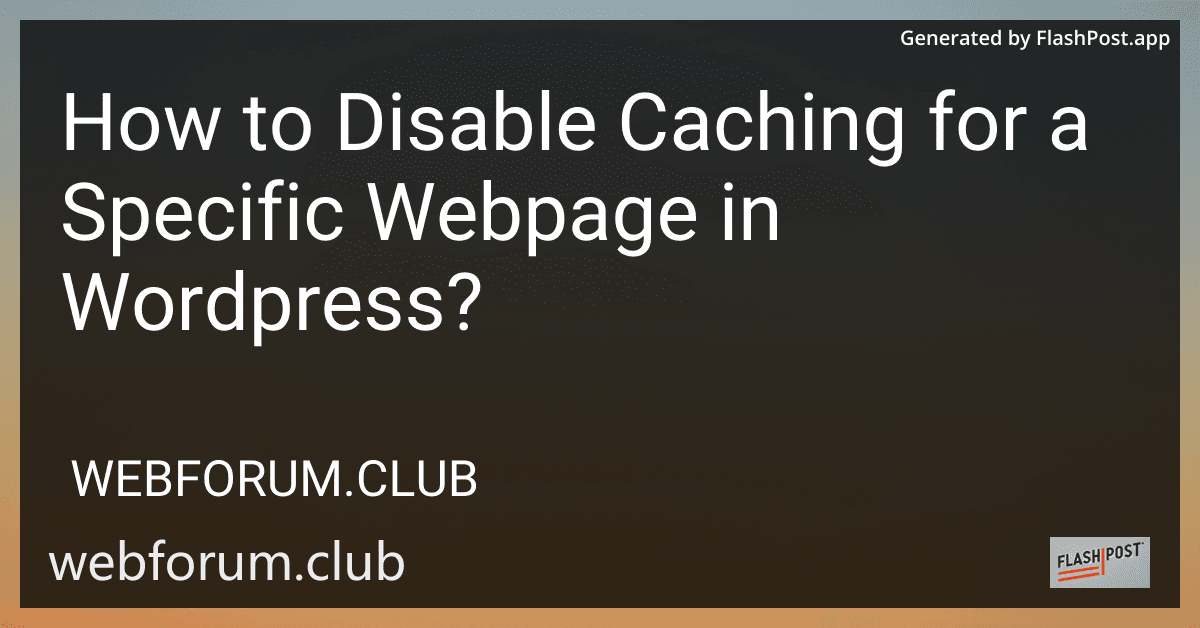title: How to Disable Caching for a Specific Webpage in WordPressdescription: Learn how to effectively disable caching for a specific webpage in WordPress to ensure dynamic content is always served fresh. Follow our step-by-step guide.
keywords: WordPress, disable caching, specific webpage, caching plugins, website performance
In today’s fast-paced digital environment, ensuring your website acts swiftly and efficiently is critical. Caching is a popular method to enhance website performance, but there are times when you might want to disable caching for a specific webpage in WordPress. This guide will walk you through the steps to achieve that with ease.
Why Disable Caching?
Caching significantly boosts website load times by storing copies of web pages in a cache, but certain pages, especially those that display dynamic content, may need real-time updates. Here’s why you might want to disable caching:
- Dynamic Content: Pages with content that regularly changes, like user profiles or shopping carts, should be fresh on every load.
- Testing and Development: Developers frequently need immediate feedback after implementing changes.
- Form Functionality: Pages with forms may not reflect inputs accurately if cached.
Methods to Disable Caching for a Specific Page
1. Use Caching Plugin Settings
Many caching plugins, such as W3 Total Cache and WP Super Cache, allow you to specify pages that should not be cached.
Steps:
- Access Plugin Settings: Navigate to Settings in your WordPress dashboard and select the caching plugin settings.
- Page Rules: Look for an option for page rules or query strings.
- Add Rule: Add a rule to exclude the specific webpage from caching by entering its URL.
2. Use Page-Specific Cache-Control Headers
Setting HTTP headers directly can inform the browser not to cache specific pages.
Steps:
-
Access the Theme Editor: Go to Appearance > Theme Editor in your WordPress dashboard.
-
Edit functions.php: Locate and open the
functions.phpfile. -
Add Code:
function no_cache_for_specific_page() { if (is_page('your-page-slug')) { header("Cache-Control: no-store, no-cache, must-revalidate, max-age=0"); header("Pragma: no-cache"); }}add_action('send_headers', 'no_cache_for_specific_page');Replace
'your-page-slug'with the specific page’s slug.
3. Use .htaccess Rules
For servers running Apache, modify the .htaccess file to include conditions preventing caching.
Steps:
-
Access .htaccess File: Use an FTP client or your hosting control panel to access the
.htaccessfile. -
Add Code:
<FilesMatch "your-page-url"> Header set Cache-Control "no-cache, no-store, must-revalidate" Header set Pragma "no-cache"</FilesMatch>Replace
"your-page-url"with the specific webpage URL.
Additional Resources
For comprehensive guides on disabling caching in various contexts, consider these articles:
- How to Completely Disable Caching in CakePHP
- Disable Caching of Widget in WordPress
- How to Disable Caching in Opera
Conclusion
Disabling caching on a specific WordPress page is essential when you need to ensure real-time content updates. By choosing the right method - whether through plugin settings, custom coding, or server rules - you can maintain both the performance and functionality of your website. Visit our detailed guide on disabling caching in WordPress for further insights.
By carefully considering when and where to disable caching, you can keep your web pages dynamic and user-centric, enhancing the overall user experience.“`
Make sure to replace any placeholder text such as 'your-page-slug' or "your-page-url" with actual data from your website. This guide offers a practical approach to managing caching, thereby ensuring your webpages remain up-to-date and reliable.
